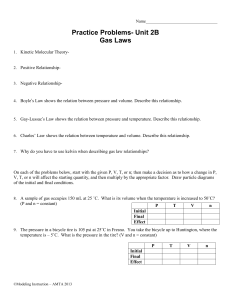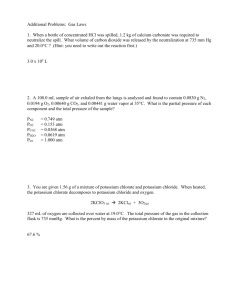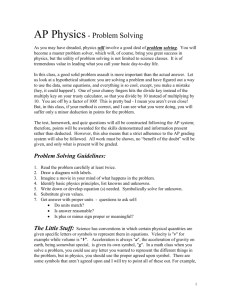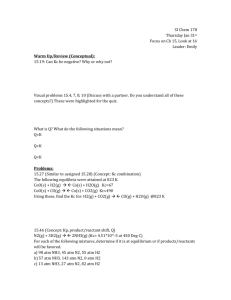Dalton`s Law of Partial Pressures
advertisement
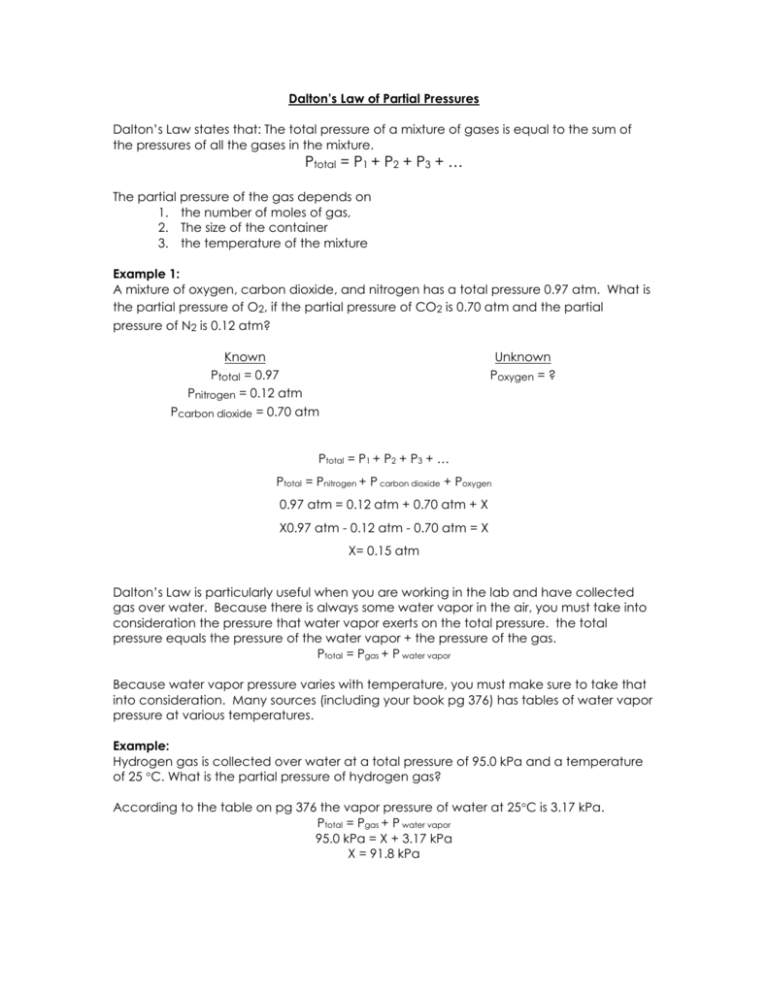
Dalton’s Law of Partial Pressures Dalton’s Law states that: The total pressure of a mixture of gases is equal to the sum of the pressures of all the gases in the mixture. Ptotal = P1 + P2 + P3 + … The partial pressure of the gas depends on 1. the number of moles of gas, 2. The size of the container 3. the temperature of the mixture Example 1: A mixture of oxygen, carbon dioxide, and nitrogen has a total pressure 0.97 atm. What is the partial pressure of O2, if the partial pressure of CO2 is 0.70 atm and the partial pressure of N2 is 0.12 atm? Known Ptotal = 0.97 Pnitrogen = 0.12 atm Pcarbon dioxide = 0.70 atm Unknown Poxygen = ? Ptotal = P1 + P2 + P3 + … Ptotal = Pnitrogen + P carbon dioxide + Poxygen 0.97 atm = 0.12 atm + 0.70 atm + X X0.97 atm - 0.12 atm - 0.70 atm = X X= 0.15 atm Dalton’s Law is particularly useful when you are working in the lab and have collected gas over water. Because there is always some water vapor in the air, you must take into consideration the pressure that water vapor exerts on the total pressure. the total pressure equals the pressure of the water vapor + the pressure of the gas. Ptotal = Pgas + P water vapor Because water vapor pressure varies with temperature, you must make sure to take that into consideration. Many sources (including your book pg 376) has tables of water vapor pressure at various temperatures. Example: Hydrogen gas is collected over water at a total pressure of 95.0 kPa and a temperature of 25 C. What is the partial pressure of hydrogen gas? According to the table on pg 376 the vapor pressure of water at 25C is 3.17 kPa. Ptotal = Pgas + P water vapor 95.0 kPa = X + 3.17 kPa X = 91.8 kPa Dalton’s Law Problems 1. A mixture of neon and argon gases exerts a total pressure of 2.39 atm. The partial pressure of the neon alone is 1.84 atm. What is the partial pressure of the argon? 2. What is the partial pressure of water vapor in an air sample when the total pressure is 1.00 atm, the partial pressure of nitrogen ins 0.79 atm, the partial pressure of oxygen is 0.20 atm and the partial pressure of all other gases in air is 0.00044 atm? (0.01 atm) 3. What is the total gas pressure in a sealed flask that contains oxygen at a partial pressure of 0.41 atm and water vapor at a partial pressure of 0.58 atm? (0.99 atm) 4. Find the partial pressure of oxygen in a sealed vessel that has a total pressure of 2.6 atm and also contains carbon dioxide at 1.3 atm and helium at 0.22 atm. (1.1 atm) 5. A 450 cm3 sample of H2 is collected over water at 10 C. The pressure of the H2 and water vapor is 78.5 kPa. What is the partial pressure of the dry H2 gas? (watch out for the extra information in this problem…and don’t forget to use that table on pg 367). (Ans: 77.3 kPa)


